
To get to Siena you shouldn't use the autobahn but take the old roads
that have always led to Siena. Your company will be blooming acacia,
Judas trees, kiwi-plantings, sempre verde, peach trees, tree nurseries
and workshops for terracotta sculptures. Then there's the town with the
funny name: Poggibonsi, which was completely destroyed in the second
world war and rebuilt.
It was this town where Michelangelo had slept in an Albergo on his
flight from Pope Julius II, the so-called soldier-pope, whose pigheadedness
at least was similar to that of his favourite artist. Michelangelo had enough of
Julius' quirks and the to and fro of the making of Julius' grave.
The Florentine had gained several enemies in Rome, mostly envious people
like Bramante, the architect of the new building of St. Peter.
Michelangelo refused to return to pick up his work again which brought
him many credit points in Julius' respect...
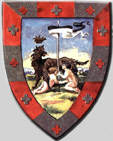 But we approached Siena finally, the red-brown town on three hills. We
stepped out of the car at the fortress of Duke Cosimo de'Medici. From here
you'll have a first look at the cathedral and the tower of the town hall, it's
an unforgettable panorama.
But we approached Siena finally, the red-brown town on three hills. We
stepped out of the car at the fortress of Duke Cosimo de'Medici. From here
you'll have a first look at the cathedral and the tower of the town hall, it's
an unforgettable panorama.
Exactly this view the Emperor Charles V must have had when he stopped here in
front of Siena's gates with his mercenary troops in 1553.
You remember perhaps his Sacco di Roma in 1527 and his later conquest of
Florence in 1530. Twenty years later he still was involved in a war with the
French king Francis I about the ruling of Italy. To Florence's
shame I must confess that this town had its hands among them because Siena
and Florence where always in a clinch.
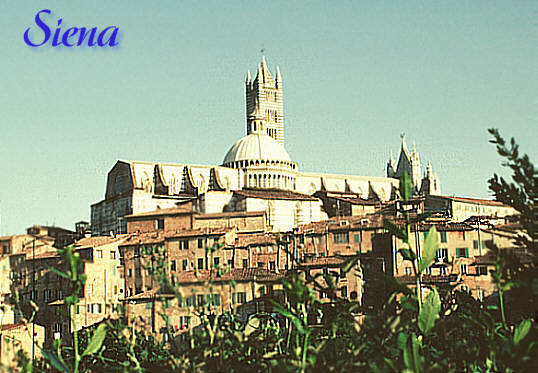
Behind Siena's walls had gathered up the civil guard, even women and French
troops. There wasn't any break through, so the siege started. One month, one
year. The town suffered from lack of food. Then the mayor made a list of all
the "superfluous mouths": over 4.000 poor people, old people, servants,
orphans, women and children. He sent them through the gates of the town into
the enemy's arms. What happened to them you can imagine yourself. The siege
held on for eighteen month then
the starving town capitulated. Charles V had straightened the way for Duke
Cosimo de'Medici, becoming part of the Duchy, sharing its fortunes until
unification with Italy.
Our first station though is the overcrowded tourist's toilet on the portal
of San Domenico. The old man has everything under control: for 1.000 Lire
even women can accompany us on the loo ;-)
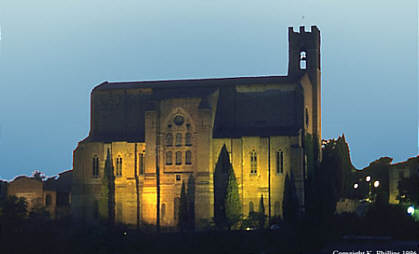
Siena is built on three hills, maintaining intact its medieval appearance
characterized by narrow winding streets and noble buildings. Of Etruscan
origin, it was a Roman colony with the name of Sena Julia; its importance
grew in the Middle Ages. The town is of great invironmental and artistic
interest with a wealth of important monuments including Piazza del Campo,
one of the most beautiful medieval squares in Italy,
Palazzo Pubblico (13-14th century in gothic style), overlooked by the bold
Torre del Mangia (102 m high). In Piazza del Duomo lie the Duomo, one of the
best examples of Gothic in Ithaly, with beautiful graffito and intarsia
flooring, Libreria Piccolomini and the 14th century
Baptistery (font by Jacopo della Quercia), the Spedale di S Maria della
Scala (13-14th century) and the remains of the Duomo Nuovo.
Famous people are: Jacopo della Quercia (sculptor, 1361-1438), Duccio di
Buoninsegna (artist, 1255-1319), Simone Martini (artist, 1284-1344),
Ambrogio and Pietro Lorenzetti (artists, ca. 1280-1345), Saint
Catherine (1347-1380).
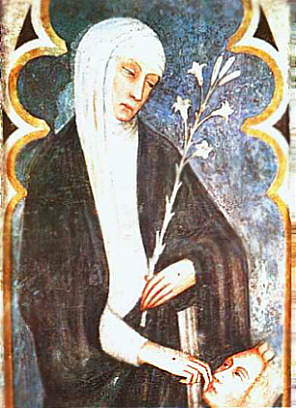
Apropos Saint Catherine: we were standing in front of San Domenico, the
church that houses her mummified head.The interior of this red
brick wall-building was empty and cold, a typical church of a beggar's
order, just right there was a bright-coloured chapel whose walls
were covered with freschi showing the life of Catherine. From a tabernacle
two dead eyes stared at us. They belong to the mummified head of Catherine;
the remaining mortal body is resting in Rome. It looked as if she was about to smile.
Caterina Benincasa was born in 1347 the 24th and last child of a dyer's family
in very modest circumstances. It was the time of civil wars, power
struggles and family feuds; the pope resided in Avignon in dependence of the
French rulers; nobility suppressing the folk. When only six
years old Caterina had her first vision amid a street, at seven she took a vow
of virginity. From then on she lived like an ascetic. At twelve she should
marry but refused and her parents got angry. When her face became blemished
from scars of smallpox (perhaps she had prayed for them), she lived just
retired at home.
Well, to cut a long story short, at 18 she entered against her parent's
will the Third Order of the Dominican in Siena (The third order means you
doesn't have to live in a monastery resp. convent nor to wear a habit.
Michelangelo for instance was member of the
Third Order of the Franciscan.). She devoted her life to the care for the
ill ones and poverties and even her visionary talent appeared then. In a
mystic vision she experienced her marriage with Jesus Christ, and to mark this the
wedding ring she wore lifelong around her finger.
Mockers say Jesus had given her his foreskin to wear it around her finger ...
(sorry). With fervent prayers she asked for salvation from purgatory for
her and her family. Many, many legends are woven around her life but she
had surprising guts re the fall of the clergy and the church in general. She
dared to write pretty open letters to Avignon "What Christ had earned on his
cross, has been wasted with whores", for instance. And she didn't hesitate
"to wish the lords of the church the death in the name of the Lord."
In 1375 she was stigmatized but until her death only she could see the
wounds. One year later she travelled to Avignon to Pope Gregor XI. She could
move the pope back to Rome, but two years later the Occidental Schism
started, and she supported Urban VI, went to Rome and started to work for
the union of the church. In the long run she won although she didn't live
long enough to see it. Today she's the national saint of Italy.
Perhaps it's good that the sun isn't shining so brightly today because the
town is situated on three hills. Tight, steep alleys with cobble stones
leading to high buildings and small places. Siena is preserved when it had
reached its peak and thus car-free. But it doesn't mean that there aren't always cars
supplying the shops pushing behind your
butt. Somewhere in a dark corridor waits the monument for Pope Julius III
Chigi, then an inner yard. An archway decorated with freschi of coat of arms
and a stony cistern. Later there's a break through to the left
side and you can catch a fleeting glimpse of the Campo. But first we
followed the winding street up to the highest point of the town: the
cathedral. First you have to pass the ruins of the Duomo Nuovo.
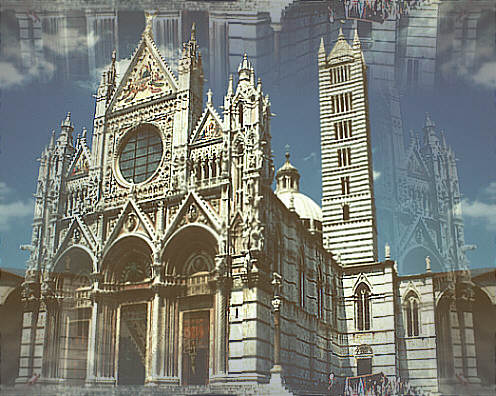
The plan was outrageous: The long nave of the present cathedral had to
become the transept of the new one! That was indeed a mind blowing plan. But
also here like in Lucca the plague and implicit faulty design put an end to
this hubris. The black and white-striped clock tower was overlooking the
place. From the monumental facade ugly
gargoyles remind me with its grotesqueness of Paris' Notre Dame.
Once through the portal you're absolutely blind. This was the most darkest
church I've ever visited. You have to stand beside the entrance for a while
before your eyes can adjust and then you'll see: the ground first, 56
squares of marble, the oldest made in graffito-technique,
where they smeared the scratched grooves with tar to make the contours
clear. There are marble-intarsia and mosaics. I saw Hermes Trismegistos who
is just known to insider. I saw the pagan Sibyls next to stories
of the old and new testament. Some of them were covered for protection. My
gaze went up from the striped walls to the blue sky of stars. And from the
cornice looked down at all the popes from Peter on, all in all they are 172. It's
not a legend that even Pope Joanne was here amid
them (later they had to remove her). In between them were the busts of Roman
emperors: Augustus, Caesar, Titus, Hadrian, Caracalla, Nerva, Trajan... what
a gathering.
 There's the third of the four Pisano-culprits. Octagonal and mighty it
stands upon nine green marble pillars, upon granite and porphyry. Four of
them are carried by lions. On the eighth side a curved staircase leads up.
Who's preaching here must feel power.
There's the third of the four Pisano-culprits. Octagonal and mighty it
stands upon nine green marble pillars, upon granite and porphyry. Four of
them are carried by lions. On the eighth side a curved staircase leads up.
Who's preaching here must feel power.
Though it's drawing me to the right chapel. It is the chapel of the
votive-Madonna or the chapel of Fabio Chigi, pope Alexander VII from Siena.
There are the hills and stars of his family's coat of arms upon the marble
ground and two statues of Lorenzo Bernini: San Girolamo and Mary Magdalene -
impressive and theatrical as I know
him. In front of the chapel hung on the wall devotional offerings in every
form, even two motorbike helmets. You can imagine the story that belongs to
it.
To the left side, on a wall-altar (the so-called Piccolomini-altar),
are two works of young Michelangelo. For
instance the figure of Saint Francis. This figure was begun by Pietro
Torrigiani, his personal enemy number one, you remember him certainly from
their fight in Florentine's Brancacci-chapel.
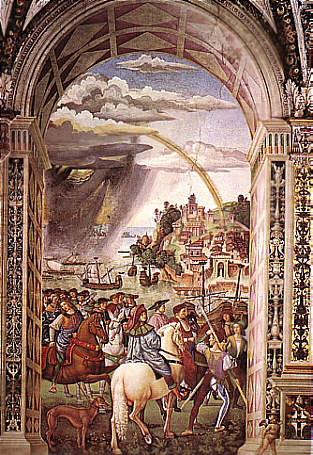 Right beside this is the entrance to the Piccolomini-library.
Right beside this is the entrance to the Piccolomini-library.
Aeneas Sylvius Piccolomini (born 1405 in Siena to a noble family)
is one of the more remarkable popes. He was considered as the 'poet of the
Holy See', more humanist than clergyman. He had started
with an early career, went to Germany and made friends
with all important personalities of Europe with whom
he exchanged letters the whole of his life. Many letters of the
young humanist spread delicate details and
detailed gossip (much to his disadvantage later).
For instance he explained to his surprised parents that the
boy he was sending them for education was their grandson
he had had with a married English woman (and whom she
had sent to his procreator nine month later).
Aeneas contacts helped to get important functions. He became
secretary to emperor Friedrich III, made a career as diplomat
(ambassador to King James I of Scotland) and he was crowned
by Friedrich III as Prince of Poetry. Aeneas wrote wonderful
poems which are still highly acclaimed. When he joined with 40
years Rome's Curia he changed from a man about town to a
chastened 'Augustinus'. Pope Nicholas V promoted him and
he became bishop ofSiena. In 1457 he was chosen as the new
pope and took the name Pius II.
In 1461 he performed the canonization of Saint Catherine
of Siena. He organized another crusade to free Costantinople
from the Turks but on the eve of the start he died in 1464
in Ancona, not even 60 years old. His merits as historian and
author are undisputed. His 'commentarii' - a sort of political
diary - important.
His birthplace Corsignano he re-named in Pienza and extended
it to a precious little Piccolomini-principality. In Siena
his family surpassed the old noble families with palaces,
loggias and libraries.
His supported newphew Francesco Todeschini-Piccolomini inherited
his uncle's library and built after 1495 a separate room in Siena's
cathedral to take the books. As painter he could get Bernardo
Pinturicchio. He painted ten big freschi describing Pius II life.
Pinturicchio ("little painter") was a little crippled man but his
talent was big. Some people don't like his bright colours, but I do.
Btw, Francesco also entered the Holy See as Pius III.
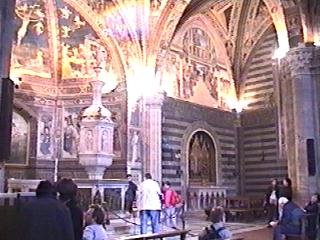
There's the baptistery waiting for a visit. You have to go down a steep
staircase to reach it. It is so far below , you could think it is the
crypt. The restorations of it had been just finished and it was clearly
visible. The walls - over and over again covered with biblical freschi - are
bright and beaming. In the middle is the famous hexagonal baptismal font
made by Jacopo della Quercia. I went around and adored the bronzed
plates he made together with other famous artists like Andrea Pisano,
Donatello and Lorenzo Ghiberti we all met before in Florence. There's the
banquet of King Herod: A slave is presenting a disgusted looking Herod the
freshly cut off head of John the Baptist. Salome is looking satisfied.
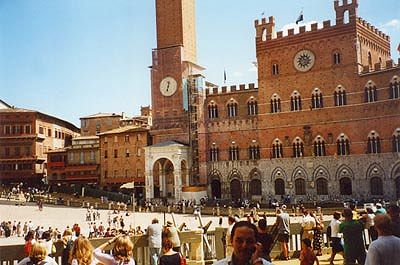
Soon enough we stood on the gentle way down to the "place of the shell",
the Campo. The place is plastered in all shades of red and is a
grandiose view and belongs to the most beautiful places in Italy. To
the left side is the Fonte Gaia - the spring of joy - made by Jacopo
della Quercia (who's often called the 'Master of the Fonte Gaia').
The square basin with the bright green-shimmering water was guarded
by two she-wolves. The she-wolf with two boys next to her you'll see
often in Siena. As the legend goes, Siena's inhabitants are descendents
of Remus, twin of Romulus, the founder of Rome.
On one wing of the town hall is the Cappella di Piazza: three open
Renaissance-arches. It's the redemption of a holy pledge given during
the period of the plague in 1348. On each second of July and sixteenth of
August a mass is read here at the start of the Palio.
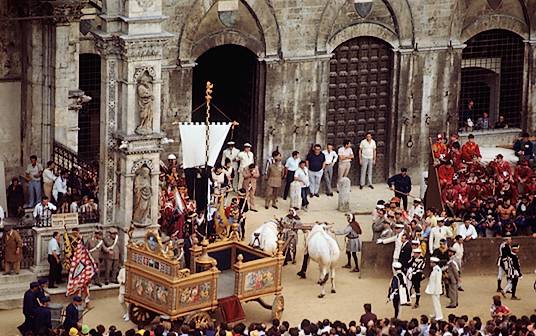 I stood and dreamt again... I dreamt the inhabitants of all seventeen
contrade (districts) into the middle of this place. The procession
starts. The horses are carried into the churches and blessed,
standard-bearer dressed in colourful, medieval costumes... I see the
banner of the tortoise, of the dragon, the caterpillar, the porcupine.
A cart of four oxen carries the Palio, the banner with the picture of
the Holy Virgin. At the end of this evening it will hang in the church
of the victorious contrade....
I stood and dreamt again... I dreamt the inhabitants of all seventeen
contrade (districts) into the middle of this place. The procession
starts. The horses are carried into the churches and blessed,
standard-bearer dressed in colourful, medieval costumes... I see the
banner of the tortoise, of the dragon, the caterpillar, the porcupine.
A cart of four oxen carries the Palio, the banner with the picture of
the Holy Virgin. At the end of this evening it will hang in the church
of the victorious contrade....
A cry is tearing the silence and ten horses with their riders storming
up, three times around the place, on this amazingly small way that is
left. It is a battle, a pure lust for winning. Winning for the contrade,
to be hero for just one day. They ride without bothering about losses.
Horses fall in the notorious curve, are bulldozed. The rider cleans
red dust from his clothes. The crowd's ear-deafening noise increases
to a hurricane. For one moment the banner of the Lupa, the she-wolf,
blinds my eyes. A horse without rider will be flagged down, but it
doesn't matter. The man is not important, just the horse and the victory.
The horse will get golden hooves and will be celebrated and cared
for that each man would be envious...
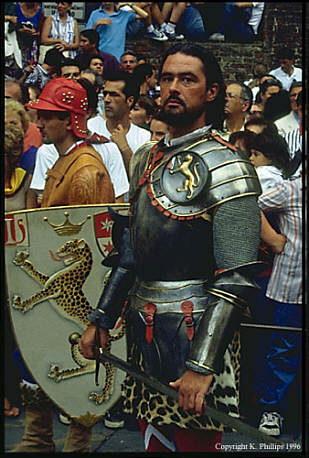
I wake up. The place has filled with school classes sitting on the red
ground, having lunch. When you find a place in one of the many restaurants
on the Campo, don't miss it. It might be expensive but it's worth all
the same. And even another thing you shouldn't miss: the famous Panforte,
a very rich cake, sold everywhere, but the best tasting comes
from Nannini, you know the family of singer Gianna Nannini and Alessandro,
the former Formula 1-driver.
In the afternoon you should visit the museum in the town hall. Even the
interior of those old Palazzi will give you the feeling that you have been
returned to the middle ages, all those staircases,
the painted walls, the smell....
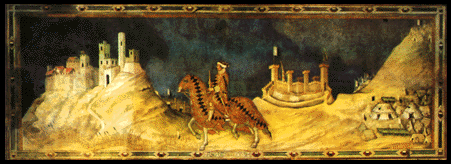
First it's the Sala Mappamondo named after the place of a turning map
of the territory of Siena (made by Lorenzetti), but it is
unfortunately lost. You can only see the place were it hung
on the wall because there are round trails from turning.
On the other side of the room
at least survived Simone Martini's Maesta, his most important
and well-known freschi (1315). Maesta means a special depiction
of the enthroned Madonna with child, surrounded by apostles, saints
and angels. Its harmonic composition makes this piece of work to
a highlight of Gothic Arts.
The most splendid rooms are the rooms of the Council, the sala dei Nove
(the nine senators of the town). First there's Simone Martini's
equestrian fresco of Guidoriccio da Fogliano (see photo), painted in
1328. Guidoriccio was a successful capitano del popolo. In the next
room (the actual room of the None) your gaze falls instantly upon
meters long freschi (14 m long) which are of outstanding meaning. If you
want to comprehend the feeling of the ending middle ages just go
to Siena's town hall and you'll have everything you need to understand.
It's the work of the brothers Lorenzetti, but most of all of Ambrogio
and was finished in 1338. The names The Good and Bad Government
it received in the 18th century. Lorenzo Ghiberti named them
Peace and War. Under the guelph government of the Nove, mostly
represented by merchants, Siena was experiencing its heyday
and received the appearance it still has today.
The councillors had their place on a tribune on the window side and
therefore had the Good Government, Peace and Concordance
always in mind's eyes. The Bad Government and War remained to the left
- on the inferior side and hence in shadow. If you want to learn
more about the allegoric picture program click
here
A little offside is situated the antique Fonte Branda, the
most famous well of town, noticed since 1081. It's made from
brickstone and connects three pointed arches with a crown
of a merlon. And right beside you'll reach the entrance to the
pilgrimage church of Saint Catherine. The builidng - once
occupied by the saint - had been changed into a church and museum
in 1464. It's a beautiful brickstone-complex with yard, wells,
gardens and living rooms changed into oratorio's, wonderful equipped
with freschi and statues. You shouldn't miss a visit.
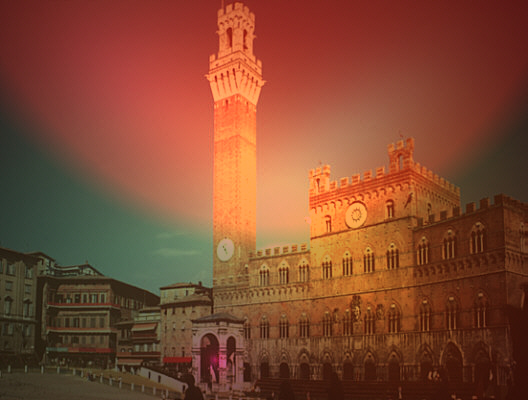

 But we approached Siena finally, the red-brown town on three hills. We
stepped out of the car at the fortress of Duke Cosimo de'Medici. From here
you'll have a first look at the cathedral and the tower of the town hall, it's
an unforgettable panorama.
But we approached Siena finally, the red-brown town on three hills. We
stepped out of the car at the fortress of Duke Cosimo de'Medici. From here
you'll have a first look at the cathedral and the tower of the town hall, it's
an unforgettable panorama.





 There's the third of the four Pisano-culprits. Octagonal and mighty it
stands upon nine green marble pillars, upon granite and porphyry. Four of
them are carried by lions. On the eighth side a curved staircase leads up.
Who's preaching here must feel power.
There's the third of the four Pisano-culprits. Octagonal and mighty it
stands upon nine green marble pillars, upon granite and porphyry. Four of
them are carried by lions. On the eighth side a curved staircase leads up.
Who's preaching here must feel power.
 Right beside this is the entrance to the Piccolomini-library.
Right beside this is the entrance to the Piccolomini-library.


 I stood and dreamt again... I dreamt the inhabitants of all seventeen
contrade (districts) into the middle of this place. The procession
starts. The horses are carried into the churches and blessed,
standard-bearer dressed in colourful, medieval costumes... I see the
banner of the tortoise, of the dragon, the caterpillar, the porcupine.
A cart of four oxen carries the Palio, the banner with the picture of
the Holy Virgin. At the end of this evening it will hang in the church
of the victorious contrade....
I stood and dreamt again... I dreamt the inhabitants of all seventeen
contrade (districts) into the middle of this place. The procession
starts. The horses are carried into the churches and blessed,
standard-bearer dressed in colourful, medieval costumes... I see the
banner of the tortoise, of the dragon, the caterpillar, the porcupine.
A cart of four oxen carries the Palio, the banner with the picture of
the Holy Virgin. At the end of this evening it will hang in the church
of the victorious contrade....



